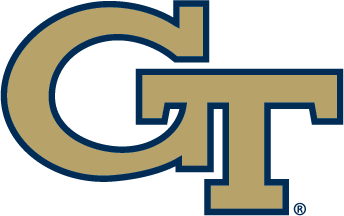Dec. 23, 2010
By Jon Cooper
Sting Daily
– It’s been 36 years since Joe Harris last set foot on the field of Bobby Dodd Stadium as a player and 28 since he last played football, following his six-year NFL career.
Yet, his legend lives on.
Harris, who stood 6-1, 225, played from 1972 through ’74, primarily at inside linebacker. He still holds the school single-season record for tackles by a linebacker (188) and ranks eighth with 415 career stops. It should be noted that he did this in three seasons, as in his day freshmen were ineligible.
Harris’ legend grows during bowl season, as he was a major factor in one of the most dramatic and melodramatic postseason wins in school history, Tech’s 31-30 victory over Iowa State in the 1972 Liberty Bowl.
The game, in which the Yellow Jackets overcame a 14-3 first-quarter deficit, then stopped the Cyclones on a potential game-winning two-point conversion late in the fourth, spoke volumes about the team. The Jackets’ ability to focus amid the controversy that swirled around them following the suspension of quarterback Eddie McAshan — especially the team’s African-American players — said even more about their character. No one better personified that focus and character than Harris.
A 2000 Georgia Tech Athletics Hall of Fame inductee, he is still passionate about Georgia Tech football and can be found at Bobby Dodd Stadium at every Yellow Jackets home game, where he is eager to talk about the glory days.
Harris, who recently turned 58, addressed a number of topics, including the secrets to his success, the ’72 season, the mixed emotions heading into the Liberty Bowl, and similarities in his teams and the 2010 Yellow Jackets.
STING DAILY: What are your memories of the 1972 season?
JOE HARRIS: The ’72 season was actually really one of the most exciting seasons that I had at Georgia Tech. That was my sophomore year and I got to play different positions. I played safety plus linebacker and did a lot of special things, just showing my ability and getting the opportunity to see what I was all about as an athlete. The season was really exciting.
SD: Among the biggest games that year was an upset of Michigan State in East Lansing. What do you recall from that game?
JH: I had, I think, 17 tackles playing safety, out of position. My teammates were really sometimes under-estimated. I can never forget it. When we went to Michigan State, they had all these big guys, big players, Billy Joe DuPree, Brad Van Pelt. They had these giants and it was sort of like a David and Goliath story that we beat them. The first pass that Eddie McAshan threw, the long touchdown, there was over 100,000 people in that stadium, I remember you could have dropped a pin and heard it, it was so quiet. They really could not believe that those little guys stopped their big running backs. We had a lot of belief in what we did and knew that we could overcome and make things happen.
Linebacker was normal position for me. Safety was kind of out of position, but safeties and linebackers are similar in what we do, you come up to support the run and you cover. It’s just [safeties] are a little faster. One of my positive sides was that I was a quick linebacker. That was something that was different back then. We didn’t have a lot of fast linebackers. I could run with almost anybody.
SD: How does it feel to still own the school’s single-season tackles record?
JH: It went back to a lot of things that I was doing. Every week I was meditating on what I wanted to do before the game. I would write it down on paper, and I had it on all my mirrors my goals that I wanted to do. Three days before the game, I would meditate on the things that I wanted to happen in the game and one of those things actually happened in the game. I always wanted to average at least 12 tackles a game.
I would do a lot of film study and that was one of the keys, too. I was good at body language. I could look at formations and, back then, in college, they’d dictate what’s going to happen. So I anticipated a lot. I would look at the running backs, how they stand, what they did in their motions and when they lined up, I could see and feel what they were going to do before they did it. So a lot of times they would say, ‘Do you know our plays?’ I said, ‘I don’t really know your plays but I know your body language (laughs) and I do know the formations dictate to certain things you do.’
SD: How difficult was the controversy prior to the ’72 LIberty Bowl?. How did it affect the team?
JH: The situation with Eddie was a little confusing to us because he kind of just disappeared. He didn’t say anything to us. We didn’t really know what it was. We were kind of in the middle of it because Coach Fulcher had made his decision and that’s what it was going to be but we never knew why. That was puzzling. We were in that situation, then they told us if we tried to protest, that we would lose our scholarships. So we were kind of puzzled there, too. Why? It was a really different situation for us. But we were men, we made a decision, we all grouped together and it made us come closer. We made a decision that we we would wear black armbands to represent Eddie in the game. But we couldn’t give up our scholarships because most of us were from poor families, didn’t have enough money to even go to college. So it was an opportunity for us, but we still had to try to represent ourselves and the school. It was just a few of us. We were in situations where we knew we didn’t have that much power. So we had to learn how to go along with certain things.
SD: What’s your fondest memory of the victory over Iowa State?
JH: The thing I remember was stopping that big back they had (George Amundson, the quarterback, converted from tailback, who was Big Eight Conference Player of the Year – over Heisman Trophy winner Johnny Rodgers). I think I had another 13, 14 tackles that game and I remember Bruce Elliott, after we had held them [on the two-point conversion attempt], he was jumping up and down, real excited. He came over and hugged me and said, ‘You were the Most Valuable Player. You deserve the Most Valuable Player, Joe.’ He was really excited. We all were, as a defense, because it was really tough on us dealing with a lot of big guys.
SD: Stopping bigger teams seemed to be the theme all year.
JH: That’s what I always share with people. It’s not how big you are. It’s what you have inside that drives you and if you believe in something you can always overcome.
SD: Do you see a parallel between this year’s team and yours?
JH: I see a little parallel in them because we changed into a different defense from the Bud Carson defense. We would bend but we wouldn’t break. They seem to kind of remind me of that. It takes a while to understand a different philosophy in learning defenses. It doesn’t just happen overnight. They struggled with that but you have to push on and they believe and they had a good season.
SD: How closely do you follow Georgia Tech these days?
JH: I’m at every game. As a matter of fact, I’m a member of the T-Club and I’m up here with Lucius [Sanford] and his team at every home game. I am not going to the bowl game but I will be watching it. We have a group and we’re going to have a little party for the game.









